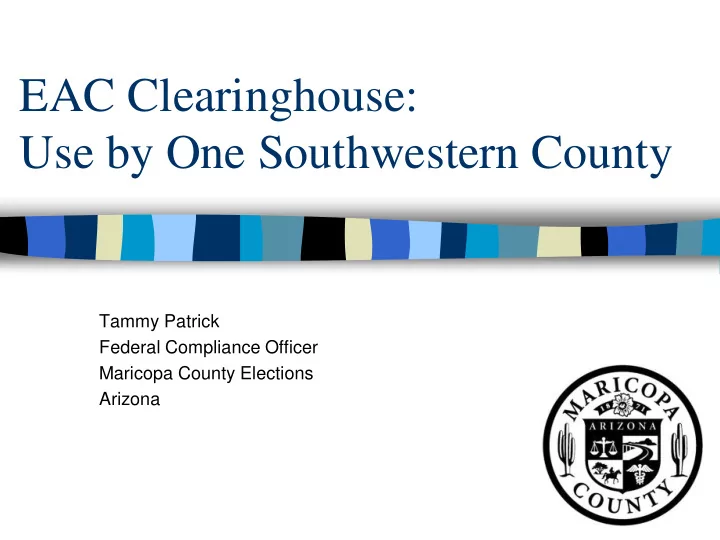

EAC Clearinghouse: Use by One Southwestern County Tammy Patrick Federal Compliance Officer Maricopa County Elections Arizona
Maricopa County Profile • 1,869,666 Active Voters (2,094,176 with Inactives) • 38% Republican • 34% Party Not Designated • 28% Democrat • (Less than 1% Green & Libertarian) • Voting Rights Act Coverage: • Section 203: Spanish & Tohono O’odham • Section 4f4: Spanish • Section 5 Preclearance • Conduct elections for all jurisdictions with exception of the City of Phoenix. • Blended system of optical scan & DREs • >½ Voters on Permanent Early Voting
Clearinghouse Resources Used: • Election Management & Quick Start Guides • Minority Language Materials • Election Day Survey Datasets • UOCAVA Studies & Research INFORMATION
EMGs & Quick Start Guides • No two elections are the same. • Processes change from one election to the next ( sometimes based on legislation). • Some occurrences are rare and a refresher helpful…
Like a recount!
Minority Language Materials: Glossary • As a Section 203 jurisdiction we translate our materials into Spanish & Tohono O’odham. • We created a glossary of local vernacular which we provide at every polling place and at training class. • We have an optional training class for our bilingual pollworkers where we discuss the tools available to aid them in serving the voters:
Minority Language Materials: Glossary • Slide from bilingual class
Minority Language Materials: Glossary • Slide from bilingual class
Minority Language Materials: Glossary • Boardworkers use the two glossaries to expand their knowledge of election- related terminology: that which is used locally, but also additional options if they are assisting a voter new to Arizona.
Minority Language Materials: Glossary • By expanding their vocabulary the worker may be more successful in communicating with voters. • The translation of “Ballot” is the perfect example: • Maricopa County Glossary: Boleta • EAC Glossary: Papeleta
Minority Language Materials: Glossary • Pollworkers want to do well and provide voters with quality assistance. • As this worker told me when we took this picture: “I’m proud to be serving my country!”
Minority Language Materials: Voter Guides • MCED attends naturalization ceremonies every Friday — usually two!
Minority Language Materials: Voter Guides • We register between 100-200 new Americans, from an average of 36 nations, each week. • After the swearing-in ceremony the line forms for SSN, VR, & Passports
Minority Language Materials: Voter Guides • The Voter Guides are a great resource for voters — particularly for those who are new to the system. Melanie & Leticia verify that forms are completed correctly & answer voter’s questions.
Minority Language Materials: Voter Guides • Informing voters demystifies the process and makes for a better electorate.
Minority Language Materials: Voter Guides • This is one of the best parts of being an election administrator!
Election Day Survey Datasets
Election Day Survey Datasets • Seek to establish common measures in three key areas: • Voter Registration • Voting & Conducting the Election • Counting & Canvassing the Election • Which are also: • Actionable • Reliable • Measureable/quantifiable
Election Day Survey Datasets • The Election Center Benchmarking Task Force turned to the data from the EAC because: • It is provided by the states to the EAC (rather than gathered by an outside source). • Central repository of uniform questions asked nationally. • Multi-year data. • Readily available. • FREE! Initial meeting in July, 2010
Election Day Survey Datasets • What we found: • Not everyone played at first — participation gets better each year. • Question interpretation matters (IE number of ballots mailed vs. number of voters mailed a ballot). • Questions changed:
Election Day Survey Datasets • By requiring the states to report this information it allows for performance management within the jurisdiction. • Not just for the LEOs, but also the public.
Election Day Survey Datasets • It also enables comparisons across like-jurisdictions.
UOCAVA Studies & Research • The studies and research gathered and analyzed by the EAC helped identify areas ripe for improvement of service to this voting population. • MCED were formal observers for the Uniform Law Commission’s Uniform Military and Overseas Voters Act which seeks to address some of these concerns.
UOCAVA Studies & Research • MCED analyzed our own processes and presented this to the TGDC in 2011. • This discussion cycles back around in the demonstration project conversation.
The symbiotic relationship between local administration and the federal government via the EAC strengthens the American electoral system.
Recommend
More recommend